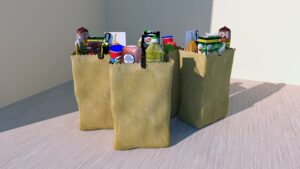
It started with empty spots on grocery store shelves amid the pandemic. As a result, food prices soared. Now, with vaccinations up and COVID-19 infections down, you might think those prices would be down.
However, grocery prices continue their upward trajectory.
Research firm NielsenIQ reports that seafood has climbed 18.7 percent while baked goods have increased 7.5 percent in the 13 week period ended April 24.
Grocery store prices overall are up 3.3 percent from March 2020 to March 2021, according to the U. S. Department of Agriculture (USDA). If you ordered from a restaurant during that time, your meal costs rose 3.7 percent.
Consumer Price Index Increase
The Consumer Price Index (CPI) rose last month to 4.2 percent over the previous April. That is the highest inflation rate since September 2008. Most importantly, the core CPI, which tracks food and energy prices rose 0.9 percent. Consequently, that was 0.6 percent above projections.
Short-Term Volatility
Food prices can move almost instantly with a change in weather, geopolitics, social unrest, and a variety of other factors.
A combination of events has come together to impact current food prices.
Oil and Supply Chain
Gasoline is used to fuel everything from tractors used in the planting and harvesting of grains, vegetables, and fruit to delivery of those products in addition to meat and fish. As a result, any price increase in oil contributes to price increases in food.
In addition to gas prices, problems in the supply chain impact not only food prices but other grocery store items. For instance, remember the toilet paper shortage?
Climate Change
Extreme weather events, as well as gradual changes, have had an impact on the food supply. The most recent major weather event is the winter storm that wreaked havoc deep into Texas.
The immediate impact of that storm was knocking out the power grid. That left people without heat and electricity as temperatures dropped to record lows. However, the long-term impact has slashed the supply of many food sources.
Losses from that one storm have been estimated at $600 million. Of that, $14 million in milk, cattle, and poultry were lost. In addition, a vast array of fruits and vegetables were destroyed.
Government Supplements
Government policy has had some effect on food costs by driving up corn prices. More corn is going into fuel tanks. As a result, less is going into stomachs.
The U. S. government pays subsidies to use corm for biofuels. As a result, the price of corn has risen and there is less corn to eat. The creation of ethanol consumes 37 percent of the nation’s corn. That’s more than six times the amount used in 2000.
The Pandemic
You’ve heard it before, but it bears repeating. The pandemic upended the food supply and helped drive up the cost of food and many other goods.
The pandemic accelerated in March of last year. Many states and cities instituted safety measures that lead to more people eating at home more often. That increased the demand for groceries. Meanwhile, nations began closing their borders to limit the spread of COVID-19. That disrupted shipping which further limited the food supply. As a result, prices went higher.
Limited Stockpiles
The World Trade Organization (WTO) limits the amount certain foods, such as corn and wheat, can be stockpiled. That policy is designed to level the playing field between countries that subsidize farmers and those that do not. This policy is effective in times of abundance. However, it worsens the problem during shortages.
Rising Meat Prices
Another factor increasing food prices is an increase in meat consumption – especially pork. People around the world are becoming more affluent. As a result, those who could not afford meat a few years ago now can.
So, you say, just raise more animals. Fine, but the animals you want to eat have to eat as well. That leads to a need for more grain. That increase in demand raises grain prices even more. That leads to higher meat prices.
The Darkness Before The Dawn
Reading all the above and watching prices climb at the grocery may lead you to think the solution is simply not to eat. That’s been tried and most agree the results are not satisfactory.
Take heart, the high prices we are experiencing today and, perhaps, for the rest of the year are not permanent.
USDA Predictions
The Department of Agriculture is expecting grocery prices to rise another one to two percent in 2021, before stabilizing as the pandemic passes. Restaurant food costs will grow by another two to three percent, says the USDA.
The Agriculture Department is even predicting beef and veal prices will drop between 1.5 to 2.5 percent by the end of the year.
Of course, the USDA projections can not predict whether a hurricane, tornado, flood or other natural disasters will disrupt the food supply.
Conclusion
There are many things you can not do about food prices. You can not increase grain yields, cut transportation costs, or change the weather. However, you are not powerless. You can exercise a plan of action to minimize the effects of rising food prices.
There are many sources for inexpensive recipes online and in publications. You can also set a budget and stick to it. Here are some other ideas for fighting food costs, and some more thoughts from Forbes and CNBC.
Read More
- Which Investments Should You Use First in Retirement?
- Inherited Stocks and How to Handle Them
- 3 Simple Steps to Follow When Planning Your Estate
If you enjoy reading our blog posts and would like to try your hand at blogging, we have good news for you; you can do exactly that on Saving Advice. Just click here to get started. Check out these helpful tools to help you save more. For investing advice, visit The Motley Fool.

Max K. Erkiletian began writing for newspapers while still in high school. He went on to become an award-winning journalist and co-founder of the print magazine Free Bird. He has written for a wide range of regional and national publications as well as many on-line publications. That has afforded him the opportunity to interview a variety of prominent figures from former Chairman of the Federal Reserve Bank Paul Volker to Blues musicians Muddy Waters and B. B. King. Max lives in Springfield, MO with his wife Karen and their cat – Pudge. He spends as much time as possible with his kids, grandchildren, and great-grandchildren.
Comments